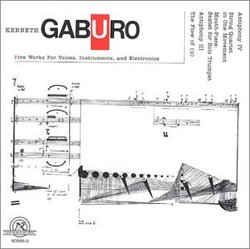| All Artists: Linda Vickerman, Walden String Quartet, KENNETH GABURO, Jack Logan, Elinor Barron, Philip Larson, New Music Choral Ensemble Title: Gaburo: Five Works for Voices, Instruments, and Electronics Members Wishing: 1 Total Copies: 0 Label: New World Records Release Date: 2/1/2002 Genres: Pop, Classical Styles: Vocal Pop, Chamber Music, Historical Periods, Classical (c.1770-1830), Instruments, Electronic Number of Discs: 1 SwapaCD Credits: 1 UPC: 093228058526 |
Search - Linda Vickerman, Walden String Quartet, KENNETH GABURO :: Gaburo: Five Works for Voices, Instruments, and Electronics
 | Linda Vickerman, Walden String Quartet, KENNETH GABURO Gaburo: Five Works for Voices, Instruments, and Electronics Genres: Pop, Classical
Kenneth Gaburo (1926?1993) composed works for instruments, voices, electronics, multi-media, theater, and a variety of other resources. Foremost among his many interests was a concern with the voice and with language?how w... more » |
Larger Image |
CD Details
Synopsis
Album Description
Kenneth Gaburo (1926?1993) composed works for instruments, voices, electronics, multi-media, theater, and a variety of other resources. Foremost among his many interests was a concern with the voice and with language?how we shape language and how we are shaped by it?and with making works that existed somewhere between the boundaries of music and language. Of the works on this CD, three are intensely concerned with what Gaburo termed ?Compositional Linguistics? (Antiphony III, Antiphony IV, and Mouth-Piece), while concerns with balance and perceptual edges seem to be his foremost concern in the other two [String Quartet in One Movement and The Flow of (u)]. In Antiphony IV (1967), for three instruments and two-channel tape, the two channels are literally separate?vocal sounds (each phoneme, in order, of the source poem) on the left channel, and electronic sounds on the right channel, with the instruments in the middle. Instrumental timbres relate to vocal phonemes; electronic splats are contrasted with delicate synthetic choirs assembled from recordings of individual phonemes; tremolos, flutters, and waverings alternate among recorded voice, electronics, and instrumental sounds. String Quartet (1956) was written just after Gaburo had returned from Rome, where he studied with Goffredo Petrassi, and the quartet is dedicated to him. It?s a passionate, driving piece, where an intense concern for the quality of line is manifest in every gesture. In Mouth-Piece (1970) the trumpeter attempts to present six contrapuntal lines simultaneously and to maintain a sense of coherent timbral identity with each. Unlike most trumpet music, where the phoneme ?t? or ?k? is used to articulate the trumpet, here the trumpet is used as a filter for every phoneme the voice is capable of generating. It is an amazing exposition of vocal sounds and trumpet virtuosity. For Antiphony III (1962), for sixteen voices and electronics, a poem by Virginia Hommel again provides the basis. Here, however, it is articulated contrapuntally, one word at a time, by both the chorus and the tape. Each word is clearly heard, sometimes spoken, sometimes whispered, sometimes shouted, sometimes electronically modified on the tape, in the order presented in the poem. The Flow of (u) (1974) consists of one note sung by three singers for twenty-three minutes. Here, focus is even more intense, and the attention to dynamic shaping given to the lines in the 1956 Stri! ng Quartet is here transferred to the micro-level, and worked on with the singers in an ?oral tradition? manner.

 Track Listings (5) - Disc #1
Track Listings (5) - Disc #1